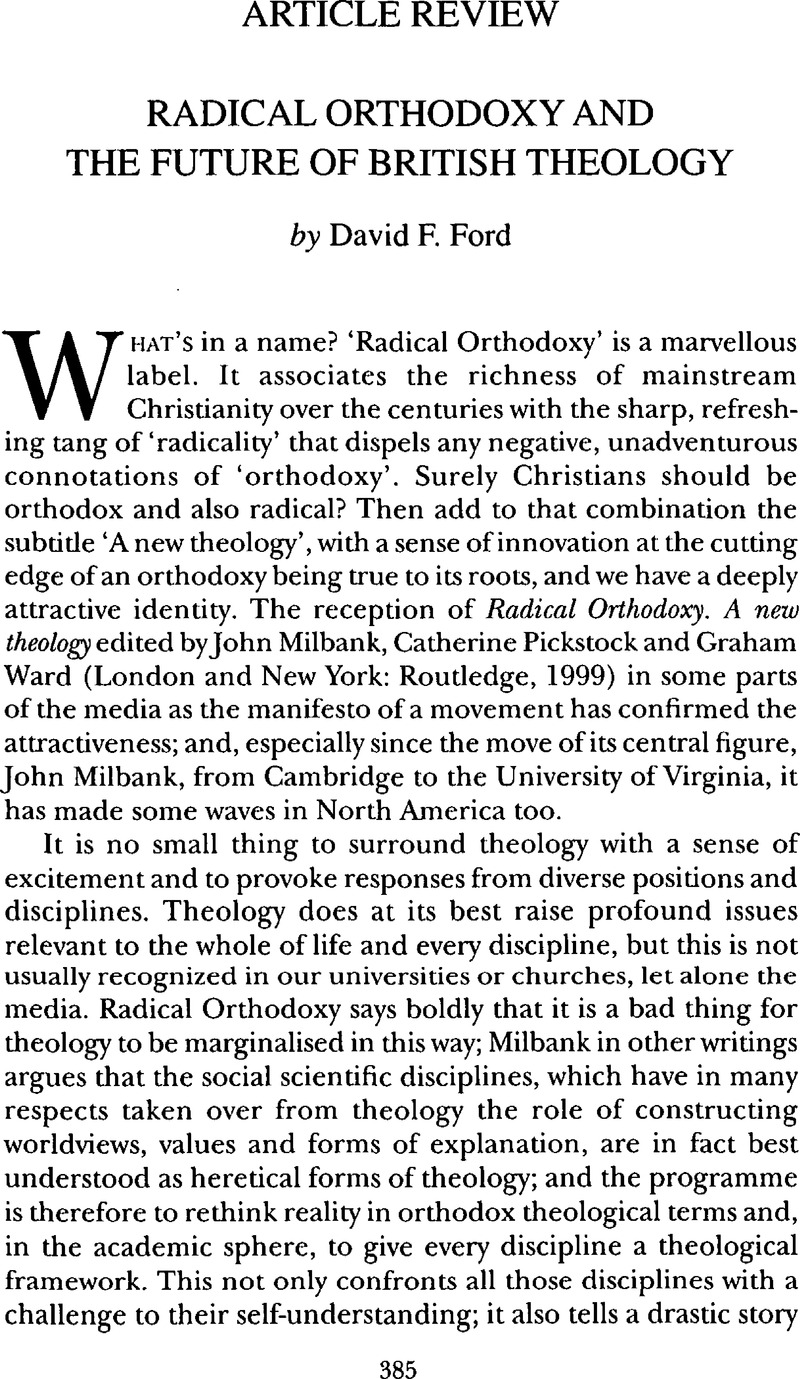Article contents
Radical Orthodoxy and the Future of British Theology
Published online by Cambridge University Press: 30 January 2009
Abstract

- Type
- Article Review
- Information
- Copyright
- Copyright © Scottish Journal of Theology Ltd 2001
References
1 Christian Century, 19–26 April 2000, p. 471. This was the third of three articles on British Theology, the others being on 5 April and 12 April, all of which will be drawn on in the rest of the present article.
2 Hemming, Laurence, editor's Introduction to Radical Orthodoxy?—A Catholic Enquiry (Aldershot: Ashgate, 2000), p. 17.Google Scholar
3 Religious Studies 36, 2000, pp. 227–31.
4 Ibid., p. 228.
5 Radical Orthodoxy, op. cit., p. 23.
6 O'Grady, op. cit., p. 229.
7 Radical Orthodoxy, op. cit., p. 3.
8 R. R. Reno, ‘The Radical Orthodoxy Project’ in First Things (February 2000, No. 100), pp. 37–44. Reno also has a much shorter review of the book Radical Orthodoxy in Modern Theology (Vol. 15 No. 4, October 1999), pp. 530–2.
9 Ibid., p. 40.
10 Ibid.
11 Ibid.
12 Ibid., p. 42.
13 Ibid., p. 43.
14 Ibid.
15 MacKinnon, Donald, Borderlands of Theology (London, 1968), p. 31.Google Scholar
16 Ochs, Peter, Peirce, Pragmatism and the Logic of Scripture (Cambridge: Cambridge University Press, 1998).CrossRefGoogle Scholar
17 A phrase he uses in response to Milbank's Theology and Social Theory in New Blackfriars, June 1992.
18 See especially his recent work On Christian Theology (Oxford: Blackwell, 2000).Google Scholar
19 Ibid.; cf. my articles in Christian Century, op. cit.
20 See especially Nicholas Lash, ‘Where does Holy Teaching Leave Philosophy? Questions on Milbank's Aquinas’ and Milbank, John, ‘Intensities’, both in Modern Theology, Vol. 15 No. 4, October 1999.CrossRefGoogle Scholar
21 Ibid., p. 440.
22 Berghahn: New York and Oxford, 1999.
23 Op. cit., p. 231.
24 For a fuller description, on which the following paragraphs draw, see my articles in Christian Century, op. cit.
25 In the Christian Century articles, op. cit. I take Rowan Williams as an example of this, and there are many others.
26 Dietrich Bonhoeffer Werke (Munchen: Christian Kaiser Verlag, 1986–1999).Google Scholar
27 Richard Roberts, in a chapter that explicitly engages with Milbank's way of relating social science to theology, finds Bonhoeffer's approach still paradigmatic for how the relationship should be conducted: ‘Theology Through the Social Sciences’ in The Modern Theologians. An introduction to Christian theology in the twentieth century, 2nd edn (ed.) Ford, David F. (Oxford: Blackwell, 1997), pp. 700ff.Google Scholar
28 For a perceptive account of the philosophical and theological achievement of Bonhoeffer in Act and Being, together with a constructive effort to relate Bonhoeffer's achievement to contemporary Anglo-American philosophy (especially Putnam and Nagel) and to assess the theological value of this in contrast with the theological value of engaging with postmodern philosophies, see Janz, Paul, Redeeming Modernity. Rationality, Justification, and Penultimacy in the Theology of Dietrich Bonhoeffer (Cambridge University Ph.D. 2000, unpublished).Google Scholar
- 1
- Cited by




